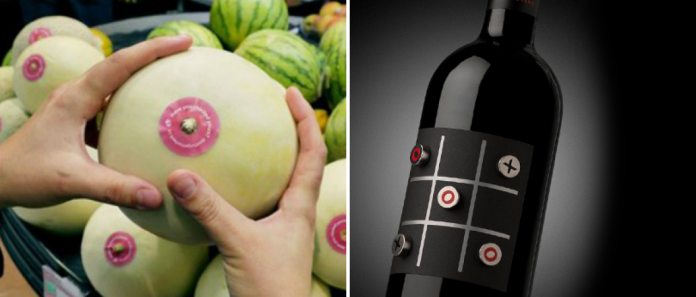We continue our story with Creapills to share 14 examples of creative labelling with you that aim to make products look smarter.
When a consumer goes to a supermarket, they are faced with many products. To choose the right product, they will of course look at the price but they will also look at the appearance that is mainly represented by the packaging and labelling. These two factors naturally make the product more attractive to the consumer and will influence their buying intention.
If for example we look at wine, a study conducted for the Barat group by Wine Intelligence revealed that a label can improve purchase intentions by up to 10%. This should not be underestimated when you launch a new product and many manufacturers are fully aware of this fact.

IN COLLABORATION WITH CREAPILLS MEDIA WHO IS DEDICATED TO DESIGN AND INNOVATION, WE WOULD LIKE TO SHARE A SERIES OF TRENDS WITH YOU THAT HAVE REVOLUTIONIZED THE WORLD OF LABELLING AND PROVED THAT BEING CREATIVE IS FUNDAMENTAL IN EVERY STEP OF DESIGNING A PRODUCT RIGHT UP TO THE POINT OF LABELLING.
PLAYING ON THE VISUAL EFFECT
It seems obvious, but unfortunately, there are far too many standard labels that look just like one another (often due to budgetary constraints). It is important to know how to alter labelling to create a visual effect and attract consumer’s attention in an aesthetic way. But be careful. This focus on graphic design should not be meaningless and must portray the product image perfectly.
Take the example below of this beer bottle created by designer, Clara Lindsten. For this fictional brand called “Origami”, the designer has created a label designed to be manipulated and transformed into origami, the famous Japanese game of paperfolding.

Another striking example is that of the creative labelling produced by the Russian designer, Yevgeny Razumov. To illustrate a brand of absinthe, this designer had the idea to alter the bottle with a label (in the shape of a bottle) that was purposely blurred. The idea was to create an optical illusion to give the impression … of the desired effect of consuming the product.

A final example of creative and visual labelling with this concept designed by the studio, T&E Polydorou Design Ltd. Here, to illustrate this bottle of olive oil, the designers simply had the idea to play with the label by creating a negative space. The label has been reworked to show a drop of oil that appears to be dripping down the bottle. It’s simple, but it’s enough for the consumer to identify the product at a glance and make the product stand out from the competition.

MAKING LABELLING A PRODUCT IN ITS OWN RIGHT
Beyond the aesthetics of a label, which remains vital to make an impression, the design can help to create a real user experience. Moving away from the traditional use for labelling to make it a true product in its own right is the kind of experience that allows brands to remain well established in the consumer’s mind for the long term.
The first example that comes to mind when talking about alternative labelling is the bookstore chain, 100,000 Books in Russia. Based on the fact that many people read everything within their reach in the bathroom, this brand had the idea to create deodorants where the labelling actually hid short stories to read … and the story-ending could of course be found at your local bookstore! Simple and really well thought out.

In a similar approach, we found this great idea from the Italian brand, Librottiglia who has differentiated itself from its competitors in a bold move. To “upgrade” the labelling on its bottles, the Librottiglia brand had the idea to turn the label into a mini-guide that tells the story and characteristics of each wine. This is an excellent brand experience for the consumer who can delve into the history of their favourite wines.

In a completely different genre, we also looked at the excellent idea from Coca-Cola Romania who decided to turn bottle labels into festival bracelets. To attract new young consumers, Coca-Cola transformed its labels into detachable bracelets that give access to festivals during the summer. A perfect example that proves how a label can have a second purpose and a new use that enhances the brand experience.
Finally, we would like to return to wine to take to look at this superb alternative labelling. The Taylors Wines brand decided to offer a real use for its bottle labels by making them heat-sensitive. So, depending on the colour code displayed, the consumer knows whether the wine is at the right temperature to drink. An intelligent idea that shows how labelling can have an interactive use that improves the use of the product.
MAKING THE SIMPLEST OF PRODUCTS SMARTER WITH LABELLING
Sometimes it is not necessary to resort to complex technology or installations to produce a smart label. A simple label placed on the right product and with the right visual (or the right wording) can sometimes be enough to make it much smarter.
Take the example of this brand of avocados (unknown) marketed in New Zealand. Because it’s not always easy to know which avocado to choose, this brand simply came up with the idea of creating a small colour-coded label that allows the consumer to know when the avocado is ripe. A perfect example that shows how a simple label, and a little bit of genius, can have a big impact on consumer satisfaction.

In the same spirit, show below is an example designed by the Canadian Breast Cancer Foundation and the agency, Rethink. To raise awareness of the importance of breast cancer screening, the association came up with the idea of using simple labels glued to melons. By playing on the analogy that makes you feel a melon to know if it is ripe before buying, this association brilliantly uses fruits to raise awareness about breast cancer screening … all with a simple label.

TURNING LABELLING INTO A GAME
Beyond simple personalized graphics, labelling can emphasize the logic of a product range in the consumer’s mind. This is a trend that is becoming more and more prominent in alcohol brands that are not afraid to play around and have fun with labelling. It’s an original and creative way of capturing the consumer’s attention.
For example, let’s go to Argentina to look at a totally unusual idea from the Estudio agency. They had the idea of designing an alternative label for a wine bottle that turns into an actual game of Morpion. The agency has created a second purpose for this bottle of wine that seemed completely normal at first by providing magnetic pawn pieces.

Let’s go to Germany to take a look at an original idea from the Beck’s beer brand. To challenge its most creative consumers, this brand had the idea of transforming its labels into a source of artistic expression. How? By simply using the same material as scratch cards allowing drawings to come alive by scratching away parts of the label. The icing on the cake is that drawings also glow in the dark.
WHEN LABELLING IS HUMOROUS
Humour and emotions are also key to a good labelling strategy. 70% of consumers consider that emotions account for 50% of their purchasing decisions. And if it is easy to show emotions in advertising, packaging and labels can also be wonderful for promoting a product in a humorous way.
Take the example of Monoprix, the retail brand that is now famous thanks to its packaging and labels that plays the humour card. Playing on words and winks in context are part of everyday life at Monoprix. The key to their success is a recognizable graphic design that stands out from many that is brand-specific and recurring. The humour used on labelling at Monoprix is part of logical content production.

Another striking example in this area is undoubtedly Innocent, the fruit juice and smoothies brand. The brand has developed a real marketing dominance focused on humour, which is featured on every bottle label. And if you take the time to read the information on the back of the bottle, you will often see word games and fun touches that add to the brand’s success.

ARE WE HEADING TOWARDS THE LABEL DISAPPEARING?
And finally, if the ultimate trend in labelling was to simply remove it altogether? In ecological and environmental terms, packaging and labelling are often under debate and manufacturers are increasingly thinking of ways to reduce plastic production … and therefore waste.
Take the example of this creative labelling for bananas designed by the creative studio Nendo in Japan. Here, the label and packaging disappear in favour of the consumer experience. The label is finally very discreet and is stuck onto one of the bananas. It peels like a banana to reveal the product information. In short, the label becomes almost invisible because it is perfectly integrated into the product, in the most discreet way possible.

We have shown you various examples that prove how labelling can also be part of the product design process. From a simple diversion to a complex transformation that opens the door to a new use, labelling is ultimately a much more complex and interesting marketing tool than we first imagine.











